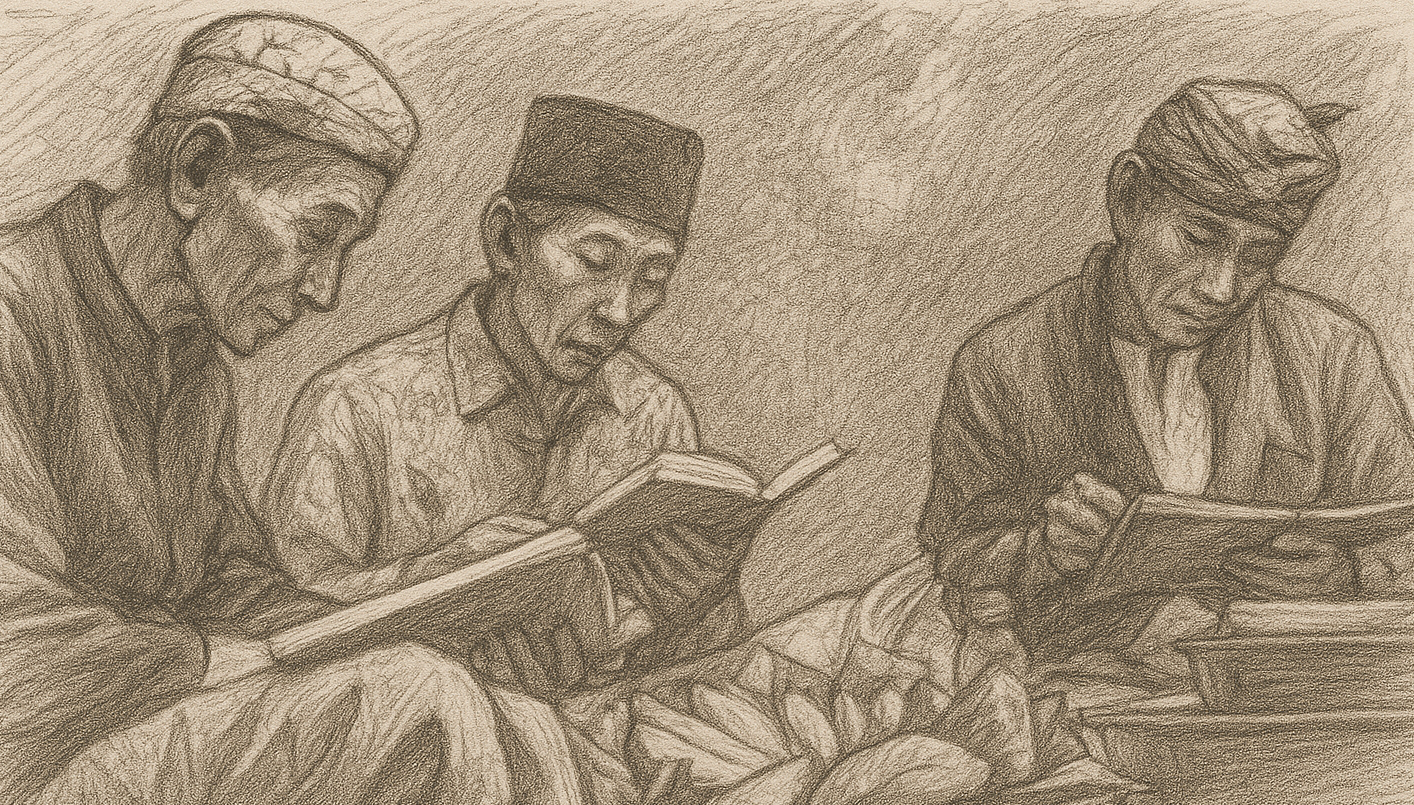The Degradation of The Role of Mamaca Art as a Medium for Proselytizing Moderate Islam
DOI:
https://doi.org/10.53088/jih.v5i2.2194Keywords:
mamaca, cultural da'wah, moderate Islam, local traditionAbstract
This research is motivated by the phenomenon of the fading of the mamaca art tradition among the Madurese community, especially in Glagahwero Village, Kalisat District, Jember Regency. The art of mamaca, which used to function as a means of cultural Islamic da'wah, has now experienced a significant decline in terms of regeneration of actors, community appreciation, and social relevance. This is exacerbated by the strengthening of scripturalist-textualist da'wah that is less accommodating to local cultural expressions. The purpose of this study is to understand the factors that contribute to the decline of the art of mamaca, examine the responses of religious leaders and artists to these conditions, and explore the implications for moderate Islamic da'wah in the contemporary era. This research employs a descriptive qualitative approach, utilizing data collection techniques that include observation, in-depth interviews, and documentation. Informants consisted of religious leaders, artists, and local villagers.The results showed that the decline of mamaca was influenced by the absence of a regeneration system, resistance to innovation, and the dominance of a literalistic religious model. The art of mamaca has the potential to be revived if it is integrated into pesantren education and local cultural programs that are more adaptive to the current context.
REFERENCESAl-Hafizh, R., Fauzi, M., Zulfan, Z., & Erman, E. (2024). Islamic Da'wah and local culture (religious reception in Nusantara culture). Mu'ashir, 2(2), 339-360. https://doi.org/10.35878/muashir.v2i2.1352
Akmaliah, W. (2020). The demise of moderate Islam: New media, contestation, and reclaiming religious authorities. Indonesian Journal of Islam and Muslim Societies, 10(1), 1-24. https://doi.org/10.18326/IJIMS.V10I1.1-24
Barros, V. (2024). Demonização do feminino e misoginia a partir do movimento de caça às bruxas. Prâksis. https://doi.org/10.25112/rpr.v1.3500
Damanik, A. Z., Awalia, A. A., Nadzifah, N., Juniarti, R., & Anshori, D. M. (2024). The role of cultural boarding schools in answering the phenomenon of cultural identity crisis. Aspirasi, 2 (5),110 -124. https://doi.org/10.61132/aspirasi.v2i5.1029
Dana, I. W., Prasetya, St. H. B., & Anggraeni, A. (2023). Conservation and development model of Mamaca in Pamekasan Madura. Recital, 24(1), 36-
Delgado, A. D. V. (2012). La desaparición de las diosas como metáfora de la pérdida de autoridad de las mujeres. Feminismo/s,20, 63-80,https://doi.org/10.14198/FEM.2012.20.04
Faldiansyah, I. (2022). Religious moderation in cyberspace: A Qur'an-based effort to restore the impression of online extremism. Tawshiyah: Journal of Socio- religious and Islamic Education, 17(2), 47-61. https://doi.org/10.32923/taw.v17i02.3337
Hidayatullah, P. (n.d.). Mamaca: Madurese oral literature. https://doi.org/10.31227/osf.io/bhcym
Ikhwan, M. (2024). When Misri is still played, when dance is still performed. Maarif. https://doi.org/10.47651/mrf.v18i2.235
Isyanto, I., Yuliastina, R., & Suhartono, S. (2023). The meaning of Mamacah tradition in the perspective of social and cultural communication. JURINOTEP, 1(3), 301-312. https://doi.org/10.46306/jurinotep.v1i3.33
Kaleta, K. I. (2024). Przemiany iconograficzne w kulcie Santa Muerte (Świętej Śmierci): Analiza wybranych przykładów. Zeszyty Naukowe Uniwersytetu Jagiellońskiego,55 (4),31-44. https://doi.org/10.4467/20844077sr.22.017.19996
Lermer, A., & Shalem, A. (2010). After one hundred years: The 1910 exhibition "Meisterwerke muhammedanischer Kunst" reconsidered. Brill. http://ci.nii.ac.jp/ncid/BB03737429
Lopes, M. C. A. (2024). Abandono do mito da mãe-preta nas obras de Conceição Evaristo. Revista de Estudos Literários da UEMS - REVELL, 3 (36), 291- 315. https://doi.org/10.61389/revell.v3i36.7777
Meyer, V. (2024). Grave matters: Ambiguity, modernism, and the quest for moderate Islam in Indonesia. Journal of the American Academy of Religion. https://doi.org/10.1093/jaarel/lfae061
Nurhidayah, Y. (2017). Revitalization of mask dance as a medium for da'wah. Idarah: Journal of Islamic Education and Education, 11(1), 21-52. https://doi.org/10.15575/IDAJHS.V11I1.1526
Paisun, P. (2010). The dynamics of cultural Islam: A study of the dialectics of Islam and local Madurese culture. El Harakah, 12(2), 153-168. https://doi.org/10.18860/EL.V0I0.450
Ritonga, E. Y. (2018). Islamic broadcasting through print media: The ideal concept, prospects and challenges. Al-Hadi, 4(1), 27-40. https://doi.org/10.54248/alhadi.v4i1.383
Rizali, N. (2012). The position of art in Islam. http://eprints.uad.ac.id/1485/1/01- tsaqafa-Nanang-Rizali-kedudukan-seni-dalam-islam.pdf
Rosário, D. M. do, & Santos, F. E. A. dos. (2024). Tambor de mina: Transformações e resistência cultural. Eventos Pedagógicos,15 (2),477- 487 https://doi.org/10.30681/reps.v15i2.12092
Shusterman, R. (2008). Art and religion. The Journal of Aesthetic Education, 42(3), 1-18. https://doi.org/10.1353/JAE.0.0013
Sumawinata, S., Suryana, T., & Subakti, G. (2022). Wayang as a media for spreading Islam in the archipelago. Journal of History Culture and Communication, 3(2), 96-111. https://doi.org/10.24042/jhcc.v3i2.8927
Supadma, S., & Dana, I. W. (2022). Mamaca development in Pamekasan Madura as a strengthening of social life harmony. Dance and Theater Review: Journal of Dance, Theater, and Puppetry, 4(2), 95-105. https://doi.org/10.24821/dtr.v4i2.6454
Urofsky, M. I. (2022). Introduction. In Religious freedom: A reference handbook (pp.1-12). https://doi.org/10.4324/9781003170525-1
Wilantini, C., & Amien, N. B. (2024). Mamaca tradition of Sumenep community: An effort to study manners in the era of Society 5.0. ICONIS, 8(1), 227-238. https://doi.org/10.19105/iconis.v8i1.899
Yuliana, D., Bamba, A., & Maviana, A. (2024). Mangkiki'. Melo: Journal of Social and Aesthetic Arts, 4(1), 48-59. https://doi.org/10.34307/mjsaa.v4i1.151

Downloads
Published
How to Cite
Issue
Section
License
Copyright (c) 2025 Ahmad Badrus Sholihin

This work is licensed under a Creative Commons Attribution-ShareAlike 4.0 International License.
Authors who publish with this journal agree to the following terms:
The author(s) retain copyright and grant the journal the right of first publication with the work simultaneously licensed under a CC BY-SA 4.0 license that allows others to remix, adapt, and build upon the work even for commercial purposes, as long as they credit the author(s) and license their new creations under the identical terms.
License details: https://creativecommons.org/licenses/by-sa/4.0/

